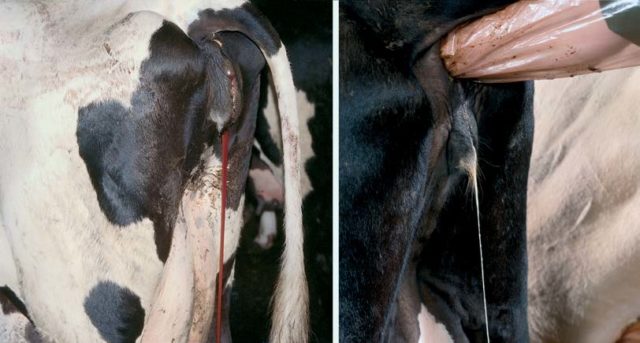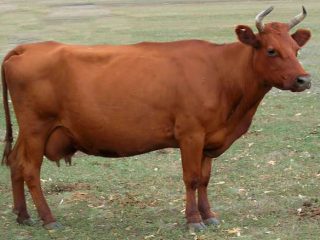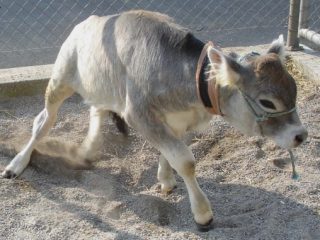Content
In a cow after a bull, white discharge occurs in two cases: leaking sperm or vaginitis. There may also be bloody (brown) mucus if endometritis develops. Often, “white” is the name given to ordinary transparent physiological discharges during and after a hunt. They are actually yellowish in color. Such freedom in terminology creates significant confusion in understanding whether the discharge in a cow is normal or is it a disease.
Why does a cow have white discharge after covering?
Normal physiological discharge from the cow's vulva is clear and yellowish. The appearance of a different color and cloudiness of the mucus indicates the presence of inflammatory processes in the animal’s reproductive system. Typically, such diseases develop after calving. After mating with a bull, inflammation can begin only if the uterine mucosa has been damaged and an infection has entered the body.
During natural mating with a bull, cervicitis may develop due to damage to the muscular or mucous membranes of the cervical canal. In this case, the appearance of purulent discharge from the vulva is possible.In this case, the appearance of the external genitalia will be far from normal. In particular, the mucous membrane will be swollen.
Colpitis
It is believed that white discharge occurs due to vaginitis. This is not entirely true. Colpitis, which is a “classic” vaginitis, is characterized by blisters on the mucous membrane of the genital organs. This is an inflammation of the vaginal mucosa. Often a consequence of other problems in the reproductive system:
- cervititis;
- endometritis;
- trichomoniasis;
- campylobacteriosis;
- birth canal injuries.
In all cases, blisters filled with one or another type of exudate form on the vaginal mucosa. The latter depends on the cause of vaginitis.
A different picture is observed with vestibulovaginitis. The nature of mucous secretions here is very diverse.
Similar white mucus is possible with purulent vestibulovaginitis
Vestibulovaginitis

Similar white mucus is possible with purulent vestibulovaginitis
The difference from vaginitis is that in this case the mucous membrane of the vaginal vestibule becomes inflamed. However, later the inflammation spreads to the vagina itself. Vestibulovaginitis is divided according to three criteria: course, nature and origin.
According to the course of the disease, they are divided into acute and chronic. Depending on the nature of the process, they are:
- purulent;
- serous;
- catarrhal;
- phlegmonous;
- diphtheritic;
- mixed.
Based on their origin, they are divided into three groups: non-contagious, infectious and invasive.
The causes of the disease may be:
- traumatic, for example, when mating with a bull;
- infectious when infected with pathogenic microflora, sexually transmitted;
- complication after infectious diseases.
There will be discharge with any vestibulovaginitis, but it will not always be white or yellow. In the acute serous form, the exudate will be almost transparent. In acute catarrhal inflammation, the mucus is cloudy and viscous. Acute purulent discharge is characterized by white, yellow and yellow-brown color. Possibly greenish too. Pus is characterized by a sharp, unpleasant odor.
In the acute phlegmonous form, there is little pus; it dries at the base of the tail. A putrid brown fluid is secreted in acute diphtheritic vestibulovaginitis.
In terms of volume, the exudate in purulent-catarrhal and chronic catarrhal vestibulovaginitis is most similar to ordinary physiological mucus. The difference is the admixture of pus. The discharge itself can be either liquid or thick.
Why does a cow have yellow discharge after insemination?
It is highly likely that yellow discharge appears due to endometritis. This is an inflammation of the uterine mucosa, usually occurring as a complication of difficult calving. As a result, by the time of mating with a bull, the disease has progressed far enough for the exudate to become yellow, or even brown from blood.
Discharge from endometritis can also be mucous. The nature of the discharge depends on the form of the disease: catarrhal, purulent or fibrinous. With the first, mucus is released, with the second, pus, with the third, fibrin films are present in the mucus.
In all cases, the most dangerous is pus mixed with coagulated blood. Such discharge will appear dark yellow or brownish. This color means that inflammation has reached the blood vessels and damaged them.

With fibrinous endometritis, the discharge can be not only brown, but also clearly bloody; with purulent endometritis, white, opaque mucus flows from the uterus
What to do if a cow has a discharge after a bull
In this case, the actions directly depend on the appearance and time of the discharge. If a cow begins to leak thick white fluid from her vulva immediately after a natural mating with a bull, there is probably no need to worry. No infection develops so quickly. Provided that the animal was healthy before insemination. But in the first 15 minutes, bull sperm may flow from the vagina of the uterus.
If there are diseases of the reproductive organs, the discharge will be “colored”.
Nature is a great reinsurer. The portion of ejaculate that a bull ejects during mating would be enough to inseminate a hundred queens. Excess sperm is either gradually absorbed by the female’s body or flows out.
The second option: transparent thick and sticky mucus, which appears 2-3 days after mating with a bull or insemination. The duration of such discharge is from a month to two. They indicate that the cow has become pregnant.
This discharge stops after 1-2 months. But to be sure that the cow is pregnant, she must be examined rectally a month after mating.
The appearance of cloudy discharge 1 or more days after mating indicates the development of an inflammatory process. In this case, it is necessary to begin treatment of the cow. But usually all diseases of the uterus and vagina develop after calving as a complication.A cow can have white, yellow and brown discharge before mating with a bull only if the owner of the animal did not pay attention to the onset and development of the disease.
But this happens already 9 months after the animal is fertilized by a bull. And the mucus is not white, but yellowish. May be slightly cloudy. It begins to shed approximately 2 weeks before calving.

Such abundant cloudy discharge is not normal under any circumstances and most likely indicates advanced endometritis
Treatment
For colpitis, the cow’s vagina is irrigated with disinfectant solutions:
- soda;
- hydrogen peroxide;
- furatsilina;
- rivanol.
In case of severe damage, tampons with disinfectant ointments are inserted into the vagina: streptocidal, Vishnevsky, ichthyol and others like them.
For cervicitis, the cow's vagina is irrigated with Lugol's solution or potassium permanganate, after which the exudate is removed and the cervical canal is lubricated with ichthyol or iodoform-tar ointment using a tampon.
Treatment of vestibulovaginitis depends on its type. For serous, catarrhal and purulent inflammation, the cow's vagina is douched with a solution of furatsilin, ethacridine lactate or a 2% solution of baking soda. Next, antiseptic liniments are applied to the mucous membranes: syntomycin, streptocide, Vishnevsky. For phlegmonous and diphtheria, washing is similar, but 1% novocaine powder is added to the liniments.
In case of endometritis, the animal is placed in improved conditions. 50 ml of a 2% cold Vagotil solution or 500 ml of Lugol's solution is injected into the cow's uterus.After this, the contents of the uterus are pumped out with a vacuum pump and antimicrobial boluses are placed inside the cow. Neurotropic drugs, vitamin A and ergot derivatives are injected subcutaneously. The Mosin blockade is also used. General therapy is indicated.
Preventive actions
Normal physiological secretions that indicate the possibility of fertilization often stick to the cow's tail and attract flies. To avoid infection of the genitals after mating with a bull, it is necessary to maintain hygiene of the external genitalia: the vulva and tail are washed daily with warm water and wiped dry. At the same time, the owner can make sure that there are no problems or notice the disease in time.
To prevent gynecological problems in a cow, it is necessary to comply with housing and feeding conditions. Predisposition to endometritis is often increased by a lack of vitamins and lack of exercise, which reduce the animal’s immunity.
Conclusion
A cow after a bull should ideally have no white discharge at all, unless this is the very first minutes after mating. In a healthy uterus, the mucus should be clear both after mating and before calving.








